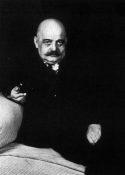
No Harem
Gurdjieff and the Women of The Rope
by Rob Baker
"No harem, no hysteria, no ogling,
just a very wise old man
in his rich pantry of food and thoughts."
Janet Flanner on visiting G. I. Gurdjieff in Paris after WW II.
During most of the Thirties and Forties in Paris, an extraordinary group of strong-willed women, mostly writers who also happened to be lesbians, became students of the spiritual teacher, G. I. Gurdjieff, meeting privately with him as a small band that called themselves "The Rope." Their ties with Gurdjieff radically changed their lives, their writing styles, and their relationships to each other.
Several of the Rope members were also close acquaintances of Gertrude Stein, who by no means shared their enthusiasm for their spiritual teacher. But Gurdjieff was, in his way, as unconventional a spiritual teacher as Stein was a writer. He often employed shock techniques that today would be seen to resemble those associated with Zen or Sufi masters. Kathryn Hulme, who later went on to write the best-seller The Nun's Story, recounts one such experience in an unpublished letter to Jane Heap, a fellow writer who had been the person who first introduced her to Gurdjieff's ideas:
We got off at Cafe Select and walked down Montparnasse. He said to me, You funny person, I not understand you. And we walked on. At a corner near the Gare he turned abruptly, said, No, that place too strong for you, we go other place. And so we walked beyond the Gare and came to a house which I spotted instantly as one of the so-called hot spots of Montparnasse. He said, looking up at the shuttered windows—Nice house, new house—and in we went. It was packed with men, and naked girls dancing together with only a twist of silk around the loins. He was watching me in his way, but I truly was not shocked or astonished; I've seen things in my time and felt nothing inside which would have told itself to him. We took a small table and had two Perrier's. It was strange being in a place like that with him. I can't tell you what all my thoughts and emotions were, they went so fast. Naked girls brushing buttocks past our table, and men reaching out to them—that sort of thing. He watched everything. I never felt so safe or so secure in all my life—and yet, all the while, he was baiting me. He said, What is your taste? He wanted me to pick the girl I would choose if I were man, he said. I simply could not, I said; They all look alike to me, smell alike. Choose, he said, which one.
Hulme tried to pass the test by standing the two Perrier bottles side by side and insisting that she could no more choose between the two bottles than choose one of the women above the others. Gurdjieff nodded slyly, but then pointed out that one bottle was fuller than the other, and that, similarly, there were hostesses in the room whose asking price was higher than the regular "girls." Hulme began to see that her seemingly simple reactions to the situation and her real inner attitudes about it might be far more complex than she had suspected. In the letter to Heap, she continues:
Then, after a long time of staring around, he turned suddenly and said—Suppose, example, you out there, no clothes, I here; I choose you, why? Because I see (and he put his hands over his eyes and gestured inwards) something else, he said.
~ • ~
What was this "something else" that Gurdjieff saw in these women writers of The Rope, keeping them separate from his other students and groups, regaling them at elaborate dinner parties at Parisian restaurants or cooked in his own apartment, and giving them intensive instruction in his method, often for days or weeks at a time? And what did they, in turn, see in him and his demanding "work"? The story of this relationship, far from being an account of a group of awestruck disciples and their unapproachable guru, is a lively tale of various struggles between mind and spirit, between body (including sexuality) and soul, between ideas and feelings, between conformity and non-conformity, the old and the new, tradition and modernity—all put into perspective by the shifting methods and techniques of a teacher like few others: the rascal, the rogue, the "sly man" who was Gurdjieff.
Over most of two decades, The Rope at various times consisted of the following cast of characters:
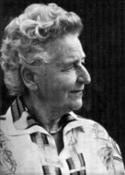 Kathryn Hulme, author of The Nun's Story (made into a film starring Audrey Hepburn), The Wild Place (winner of the Atlantic Non-Fiction Prize Award in 1953 and an account of her work in a Displaced Persons camp after World War II), and Undiscovered Country (a description of her years with Gurdjieff). A woman of boundless energy (she worked as a welder in a ship-building factory during World War II), she was also an astute and perceptive observer of life around her (and especially of The Rope). Gurdjieff made it his task to strip her of her sentimentality and tendency toward purple prose; it was an endless process, which both seemed to enjoy immensely. After several years working with Displaced Persons after World War II, she and her companion, a former nun named Marie-Louise Habets (the subject of The Nun's Story) moved to the United States, living in Connecticut, southern California, and finally on the Hawaiian island of Kauai, where Hulme died in 1981.
[Photo—from the jacket of the original Atlantic-Little Brown edition, by Senda of Kauai]
Kathryn Hulme, author of The Nun's Story (made into a film starring Audrey Hepburn), The Wild Place (winner of the Atlantic Non-Fiction Prize Award in 1953 and an account of her work in a Displaced Persons camp after World War II), and Undiscovered Country (a description of her years with Gurdjieff). A woman of boundless energy (she worked as a welder in a ship-building factory during World War II), she was also an astute and perceptive observer of life around her (and especially of The Rope). Gurdjieff made it his task to strip her of her sentimentality and tendency toward purple prose; it was an endless process, which both seemed to enjoy immensely. After several years working with Displaced Persons after World War II, she and her companion, a former nun named Marie-Louise Habets (the subject of The Nun's Story) moved to the United States, living in Connecticut, southern California, and finally on the Hawaiian island of Kauai, where Hulme died in 1981.
[Photo—from the jacket of the original Atlantic-Little Brown edition, by Senda of Kauai]
Alice Rohrer, a San Francisco milliner, who had been Hulme's companion at the time she met Gurdjieff and who especially attracted the teacher's attention by being, importantly, the least intellectual (and most emotion-centered and spontaneous) member of The Rope. She also had money—all acquired through her own talent and ability: she had been born on a farm in Pennsylvania Dutch country but always convinced her customers she was French and from the upper classes.
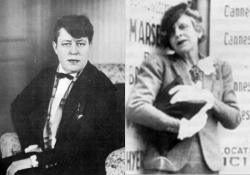 Jane Heap and Margaret Anderson, founding editors of the legendary Little Review, the literary journal which first published the poetry of Ezra Pound and T. S. Eliot in the United States, as well as the first chapters of James Joyce's Ulysses (the printing of which led to the editors' arrest and trial for alleged obscenity). The two had first met Gurdjieff in New York in 1924 and shortly relocated themselves and their magazine to Paris, partly to study with him at his institute at Fontainebleau, which he maintained until he was seriously injured in an automobile accident in 1929. Heap became a lifelong student and teacher in the Gurdjieff work, introducing most of the other Rope members to the ideas, then moved to London, where she led Gurdjieff study groups until her death in 1964. Anderson stayed in France and continued working with Gurdjieff until his death, bringing two of her companions (Georgette Leblanc and Dorothy Caruso) and even Leblanc's salt-of-the-earth housekeeper, Monique Serrure, into The Rope as well. She published three volumes of her own autobiography (My Thirty Years War, The Fiery Fountains, and The Strange Necessity), as well as her own account of the Rope years, The Unknowable Gurdjieff.
[Heap photo—Copyright © Berenice Abbott]
[Anderson photo—Copyright © 1996 Naiad Press, Inc.—taken from Forbidden Fires by Margaret C. Anderson edited and with an Introduction by Mathilda M. Hills]
Jane Heap and Margaret Anderson, founding editors of the legendary Little Review, the literary journal which first published the poetry of Ezra Pound and T. S. Eliot in the United States, as well as the first chapters of James Joyce's Ulysses (the printing of which led to the editors' arrest and trial for alleged obscenity). The two had first met Gurdjieff in New York in 1924 and shortly relocated themselves and their magazine to Paris, partly to study with him at his institute at Fontainebleau, which he maintained until he was seriously injured in an automobile accident in 1929. Heap became a lifelong student and teacher in the Gurdjieff work, introducing most of the other Rope members to the ideas, then moved to London, where she led Gurdjieff study groups until her death in 1964. Anderson stayed in France and continued working with Gurdjieff until his death, bringing two of her companions (Georgette Leblanc and Dorothy Caruso) and even Leblanc's salt-of-the-earth housekeeper, Monique Serrure, into The Rope as well. She published three volumes of her own autobiography (My Thirty Years War, The Fiery Fountains, and The Strange Necessity), as well as her own account of the Rope years, The Unknowable Gurdjieff.
[Heap photo—Copyright © Berenice Abbott]
[Anderson photo—Copyright © 1996 Naiad Press, Inc.—taken from Forbidden Fires by Margaret C. Anderson edited and with an Introduction by Mathilda M. Hills]
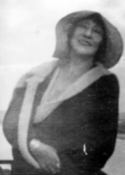 Georgette Leblanc, an esteemed soprano, once Maurice Maeterlinck's mistress and a close friend of Jean Cocteau. She was also an accomplished writer, publishing two volumes of autobiography and several children's books and travel accounts. Her prose and poetry both sing with a unique lyricism that teeters precariously between real feeling and sentimentality. The first volume of her autobiography was translated into English by Janet Flanner (one of the era's most astute observers, writing the "Letter from Paris" as Genàt in The New Yorker); the second, La Machine à Courage, deals with her impressions of Gurdjieff and (quite powerfully) her long battle with cancer, to which she succumbed in 1941, being the first of the Rope to die.
[Photo—courtesy of Elizabeth Evans, By The Way Books]
Georgette Leblanc, an esteemed soprano, once Maurice Maeterlinck's mistress and a close friend of Jean Cocteau. She was also an accomplished writer, publishing two volumes of autobiography and several children's books and travel accounts. Her prose and poetry both sing with a unique lyricism that teeters precariously between real feeling and sentimentality. The first volume of her autobiography was translated into English by Janet Flanner (one of the era's most astute observers, writing the "Letter from Paris" as Genàt in The New Yorker); the second, La Machine à Courage, deals with her impressions of Gurdjieff and (quite powerfully) her long battle with cancer, to which she succumbed in 1941, being the first of the Rope to die.
[Photo—courtesy of Elizabeth Evans, By The Way Books]
Dorothy Caruso, widow of Enrico Caruso, became Anderson's companion after Leblanc's death and describes her latter-day acquaintance with Gurdjieff in her autobiography, A Personal History. After Gurdjieff's death Anderson and Caruso moved back to United States, where Caruso died of cancer in 1955. Anderson then returned to southern France, where Monique Serrure lived with her until she died at the age of 90 in 1968. Anderson herself died there in the village of Le Cannet in 1973.
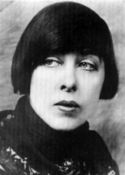 Solita Solano, writer, editor, and longtime companion of Janet Flanner (who, like Gertrude Stein, was a peripheral observer and occasional visitor to Rope sessions: both strongly resisted and rather resented Gurdjieff and his influence over the members of the Rope). Solano was for a while Gurdjieff's secretary and other than Heap was the member of the group most familiar with the intricacies of his teaching. Both Anderson and Hulme relied heavily on her advice (and superb editorial skills) in their own books about Gurdjieff. (She edited all of Hulme's books for publication.) Her personal notes of The Rope's sessions with Gurdjieff are a treasure trove of information about his method and his own personality. Through her correspondence with the other members, she became the central focus of The Rope after Gurdjieff's death in 1949 until her own death, in Orgeval, France, in 1976.
[Photo—from Library of Congress]
Solita Solano, writer, editor, and longtime companion of Janet Flanner (who, like Gertrude Stein, was a peripheral observer and occasional visitor to Rope sessions: both strongly resisted and rather resented Gurdjieff and his influence over the members of the Rope). Solano was for a while Gurdjieff's secretary and other than Heap was the member of the group most familiar with the intricacies of his teaching. Both Anderson and Hulme relied heavily on her advice (and superb editorial skills) in their own books about Gurdjieff. (She edited all of Hulme's books for publication.) Her personal notes of The Rope's sessions with Gurdjieff are a treasure trove of information about his method and his own personality. Through her correspondence with the other members, she became the central focus of The Rope after Gurdjieff's death in 1949 until her own death, in Orgeval, France, in 1976.
[Photo—from Library of Congress]
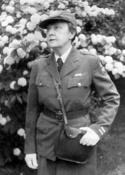 Louise Davidson, an actress and theatrical manager who, like Rohrer and Monique, related to the Gurdjieff work more through experience and feelings than words and writing. She never returned to France after moving back to the United States at the outbreak of World War II and spent her remaining years working with the theater company led by actress Eva le Galliene in Connecticut.
[Photo—Copyright © 1996 Naiad Press, Inc.—taken from Forbidden Fires by Margaret C. Anderson edited and with an Introduction by Mathilda M. Hills]
Louise Davidson, an actress and theatrical manager who, like Rohrer and Monique, related to the Gurdjieff work more through experience and feelings than words and writing. She never returned to France after moving back to the United States at the outbreak of World War II and spent her remaining years working with the theater company led by actress Eva le Galliene in Connecticut.
[Photo—Copyright © 1996 Naiad Press, Inc.—taken from Forbidden Fires by Margaret C. Anderson edited and with an Introduction by Mathilda M. Hills]
Elisabeth Gordon, a prim British spinster whom Gurdjieff, for whatever reason, chose to instruct along with the other very different personality types in the Rope; she unquestioningly accepted his decision, as did the other members. She remained with Gurdjieff in Paris when all the other Rope members were forced back to the United States during World War II; she spent a period in an internment camp as a "foreign national" near the end of the war and died in Paris shortly after being released.
~ • ~
Although Anderson, Leblanc, and Hulme all wrote books based on their experience with Gurdjieff, no objective account of the rich relationships that grew over the years between these women and their teacher (and among the members themselves) has previously been undertaken. Unlike Heap, the others did not maintain much direct contact with the rest of Gurdjieff's followers after his death in 1949, though his ideas remained a paramount influence in all their lives and in both the content and the style of their writings.
Some of Gurdjieff's other more conservative followers never quite knew how to relate to these independent and outspoken women, clearly in part because of their openness about their sexual preference. But the members of The Rope also maintained their distance as well: most of them simply went on with their lives after Gurdjieff's death.
The members kept in touch by letter and occasional visits, almost always referring to each other by the affectionate, "inner animal" names that Gurdjieff had given them: Hulme was Krokodeel (as Gurdjieff pronounced it) or Crocodile; Solano, Kanari or Canary; Alice, "Theen One" or Boa Constrictor; Anderson, Yakina (a Tibetan yak). Even occasional members of The Rope were given such sobriquets, as when Noel Murphy, a post-Solano companion of Janet Flanner, was dubbed Camel. The extensive correspondence between all these women (including letters to and from some who never really were a part of the group, like Flanner, or Solano's companion in later years, Lib Clark) makes clear that the ties that bound them all together and to the teaching were never severed. (Hulme did reestablish contact with some of the leading exponents of the Gurdjieff teaching after her book was published and traveled occasionally from Hawaii to San Francisco or Los Angeles to meet with groups there.)
~ • ~
The work-in-progress would bridge the gap that has always existed between literary chroniclers of the Stein circle and historians of the Gurdjieff movement, each of whom, for their own reasons, have preferred to downplay whatever it was that connected Gurdjieff and The Rope, ignoring the tug-of-war that went on between the literary and the spiritual avant-garde. Each side has tended to dismiss the other as somehow diminishing or compromising the quality admired in either the writing or the Gurdjieff teaching.
A few samples from Solano's notes point out the ferment of this material, a content rich in both unconventional ideas and dramatic situations that were in themselves a unique teaching device:
Oct. 23, 1935: He said he is planning a group here and that we three are to start it. He said, "You very dirty but have something very good—many people not got—very special." When I began to cry, he said, "Must not cry." I said, "But I MUST." He said, "Must—but must not.". . . When I said, "I'm too old to begin this work—it's too late," he replied, "Never too late, but now it is twice as hard."
Oct. 28, 1935: At dinner I had the misfortune—no good fortune—to ask a "mental" question. Thunderbolts fell. "Now you know your illness, your sickness. It is curiosity—American curiosity. Always you want to know more and more without understanding what already I have said to you. For that you will die MERDE." Tears from me, of course. He asked, "You angry?" I said, "No, it's true." When he left, he said, "Tonight you were bitten by your flea. You be careful not to catch more fleas or you cannot sleep in your bed."
Two of the techniques Gurdjieff used with the group were designating them according to "inner animal" metaphors (to help them better see their chief faults and potentials) and, similarly, his "toasts to the idiots" (a ritual based on his "science of idiotism" which had twenty-one different categories and levels and which he once described as a mirror in which human beings could see themselves):
May, 1936: Margaret has chosen zigzag for her idiot. G. "You cannot be zigzag." M. "But that is my condition now." G. "Condition? Your condition has nothing to do with inner world. You defile zigzag. Wish go too high. Zigzag is high idiot, goes this way, that way, struggles against merde he knows he is. Is as if you, a deacon, put on archbishop's robes."
"Idiots best book I wrote."
(To Miss G.) "You superior idiot, have been for years, never change. You are monster."
June 6, 1936: Margaret's animal was named during the afternoon at the cafe. A Tibetan yak, cousin of European cow. G: "But in your case, you not look on door of newpainted barn like cow which concerns itself only with question, 'Is that my home, or is it not?' You think like business man about quality of paint, how much cost, if will last, how react in rain—forget self completely." M. "But Mr. G., cows are placid, I don't wish to be a cow." G: "Cows not always placid; sometimes yak, this Tibetan cow, go berserk. People run inside house, shut door. Something take the psyche of this cow and entire being is wild—try break through wall—could even kill her children."
All the techniques focused on what Gurdjieff sometimes referred to as putting his followers "in galoshes." (Imagine a big, black, smelly rubber boot—big enough so you can't see your way out, you are over your head. It's dark, unpleasant, unfamiliar, confusing, frightening, disorienting. Everything you were comfortable with is taken away. You don't feel at all happy in your own skin.) In discussing the purpose of this once, he told Hulme: "I wish you be not like merde. So first I make you feel like merde. Only from there can one begin." And again, according to Solano's notes: "After roses, roses come thorns. Only then with thorns can man have possibility for happiness. After thorns comes the branching of the river, the two rivers. If not get on river which continues, you go on other, which goes down, down—and into the watercloset, moreover public watercloset." Such pricks to the analytical, mundane ego could occur at any time, even in the middle of a hearty meal:
July 24, 1936: There is a special baked eggplant dish. Yakina wonders aloud what it is and Sardine emphatically pronounces it "Aubergine" (eggplant). G: "Who tell aubergine? Sardine, you speak of only one thing. You not see in this the one thousand fly wings I put. Wing of fly is most important part, all rest of fly I throw away. Practically I will tell you what wings mean—with wings can go many places and I, night time, in dream with wings can fly. Yet you not see. First necessary see all, then speak aloud. AND aubergine."
By May 30, 1937, the members of the Rope were familiar enough with being put in galoshes themselves that Solano could report, seemingly without cracking a smile, the following incident involving the architect Frank Lloyd Wright, whose wife Olgivanna had studied with Gurdjieff before her marriage:
Dinner. Olgivanna and Frank Lloyd Wright, their child, Miss G. and K.
Wright: "Very interesting, these idiots of yours. I've invented some also." (G. Did not reply.) "Mr. G., you're certainly a good cook. You could earn a lot of money cooking somewhere."
G: "Not so much as I can earn shearing. (his way of referring to getting money from people interested in his work)."
(After dinner Gurdjieff brought out a chapter of one of his writings and asked who would read.)
Wright: "I read very well." (G. Left the room.) "Damn, I'm sleepy. I can't take it. Still, I don't want to hurt the old man's feelings." (Began to read and G. returned and sat down. Wright stopped reading.) "You know, Mr. G., this is interesting and it's a pity it's not well written. You know you talk English very well, too bad you can't dictate. Now if I had time you could dictate to me and I could write this for you in good English." (Read a few pages, stopped again.) "Now I must go and take my little daughter home. She's sleepy and so is her father."
G: "Yes, for her sake, stop. She is young. You, of course, are old man now and life finish. But she only begin."
Wright (turning red): "My life is NOT finished. I could right now make six more like her...." (Olgivanna with tears in her eyes led the child to the door.)
~ • ~
In addition to the fiery interplay that took place between Gurdjieff and The Rope, there was a second level of exchange that took place between the women and their writing—specifically between the individual writers and their attempt to capture in words the teaching and the experience they were undergoing. As Hulme describes it (beginning, as usual, with hyperbole):
You can't sit gazing at a spiritual Himalaya for days on end and remain unchanged. Many of our meaningless mannerisms vanished, and there were inner changes as well. One of mine was attested by my thickening notebook. My memory, which had always been good, developed the accuracy of a tape-recorder in Gurdjieff's company. For the first time in my life I was listening to words rooted in reality. I could take an entire evening of his talk and reproduce it afterwards on my typewriter, word for word.
But when she tried to put turn those notebooks into a book thirty years later, Hulme found herself in galoshes again. She eventually wrote to Solano for help, but her old colleague initially protested, "What weight for a crocodile to put on the back of a small bird! The responsibility to say Stop or Go!! Katie, I may not be able to judge." But after receiving the first section of manuscript a few weeks later, Kanari was almost brutally frank with Krokodeel, calling the first draft a "hodge-podge, neither a proper autobiography nor an exposition of G[urdjief]f, a burlesque of his teachings, or at best, a bad satire. It is, for pages, just plain COMIC, my dear K."
Having learned to brace her crocodile hide against such stinging pecks from her canary editor, however, Hulme fired back: "I expected almost all of what you wrote." If anything, she said, the negativity helped her find some objectivity that had been painfully lacking in her initial effort: "For the first time in two years, I have clean air around me."
Hulme's longtime agent, Bernice Baumgarten Cozzens (wife of novelist James Gould Cozzens) also intervened, pleading to Solano, "Don't wash your hands of it. She's going to need your help."
Solano relented and got to work with her famous blue pencil (actually a red pen in her case) and started transforming the heart of the book (the middle 90 pages most directly concerned with Gurdjieff) into more objective prose: "Po-o-or Krokie! You took my tuile on the tàte like a soldier," she wrote back.
Once committed, both writer and editor were locked in a friendly struggle until the final draft of the manuscript went to the publisher a year and half later. Cozzens insisted that Solano do the final trimming of the manuscript: "It would be a terrible error for anyone outside to cut," she advised Hulme. "Trust only Solita," an insider who was also "an artist of the knife."
Solano's editorial knife excised not so much whole sections as words and phrases: hyperbole, purple adjectives, overwrought metaphors, unnecessary similes, verbs that were "too fancy" when simple ones would do. She took only two adjectives (in brackets here) out of the following description, but the trim spelled salvation for the sentence: "the [stupefying] climax of Guernica, whose apocalyptic horrors only the [flaming] art of Picasso would communicate to the world." But nothing could rescue the convoluted simile about the fate of the Rope after Jane Heap left for London: "not like light-bearing Lucifers but like wingless orphans with inner lights too newly-kindled, too frail still to survive the windy draft." The sentence was axed completely.
Solano would occasionally pencil in comments such as "Oh, Katie, you are my despair!"—"Stop describing!"—"You find every word I hate, without fail"—"You cannot talk like that!"—"Damn it, this is not a guide book!" Once she let loose with "Katie behave!" in response to the following description of Gurdjieff: "He nodded thoughtfully while his glowing remembering imprinted itself on our minds like an illumined page from an old Persian poem."
Solano was also quite specific about how Gurdjieff's ideas should be presented. "The word 'sense' is out of bounds," she wrote in one margin note. And in another: "This would seem ridiculous, Katie, in this form. You can't have it!" When Hulme used the phrase "by lapsing into materiality," Solano quickly pointed out, "But, Katie, we had NOT left it!"
Anything too personal or sentimental (Hulme's eternal bugaboo: her crocodile tears) Solano also resisted. When Hulme went overboard describing her own grief at her mother's death, Solano pecked: "No, no, no. You spoil it. You cannot have domestic business like this. Your grief is obvious."
In the end, the resulting collaboration, Undiscovered Country, was a success, pleasing even critics as skeptical as Anderson: "All your effort, your WORK, your REAL LOVE for him, all your real emotions … When emotions are authentic, neither the general public nor the clever critics can doubt that truth, or help being moved."
Another especially positive response came from Jeanne de Salzmann, the longtime associate whom Gurdjieff left in charge of his groups worldwide on his death in 1949. "Reading your book, I had a very strong feeling of the presence of M. Gurdjieff, with all his strength, his kindness, his greatness," she wrote Hulme. "It is a picture which moves you deeply and which you cannot forget—of the relation between a teacher and his pupil—the way he opens her to a wider world through a relation which touches the whole of her being.… There is a kind of sincerity, of truth, which makes one feel belonging to the same source."
~ • ~
[Rob Baker was a former co-editor of Parabola Magazine. He wrote frequently on the arts for such publications as DanceMagazine, The Chicago Tribune, The Soho Weekly News, and The New York Daily News. He is the author of The Art of AIDS: From Stigma to Conscience.]
 Kathryn Hulme, author of The Nun's Story (made into a film starring Audrey Hepburn), The Wild Place (winner of the Atlantic Non-Fiction Prize Award in 1953 and an account of her work in a Displaced Persons camp after World War II), and Undiscovered Country (a description of her years with Gurdjieff). A woman of boundless energy (she worked as a welder in a ship-building factory during World War II), she was also an astute and perceptive observer of life around her (and especially of The Rope). Gurdjieff made it his task to strip her of her sentimentality and tendency toward purple prose; it was an endless process, which both seemed to enjoy immensely. After several years working with Displaced Persons after World War II, she and her companion, a former nun named Marie-Louise Habets (the subject of The Nun's Story) moved to the United States, living in Connecticut, southern California, and finally on the Hawaiian island of Kauai, where Hulme died in 1981.
[Photo—from the jacket of the original Atlantic-Little Brown edition, by Senda of Kauai]
Kathryn Hulme, author of The Nun's Story (made into a film starring Audrey Hepburn), The Wild Place (winner of the Atlantic Non-Fiction Prize Award in 1953 and an account of her work in a Displaced Persons camp after World War II), and Undiscovered Country (a description of her years with Gurdjieff). A woman of boundless energy (she worked as a welder in a ship-building factory during World War II), she was also an astute and perceptive observer of life around her (and especially of The Rope). Gurdjieff made it his task to strip her of her sentimentality and tendency toward purple prose; it was an endless process, which both seemed to enjoy immensely. After several years working with Displaced Persons after World War II, she and her companion, a former nun named Marie-Louise Habets (the subject of The Nun's Story) moved to the United States, living in Connecticut, southern California, and finally on the Hawaiian island of Kauai, where Hulme died in 1981.
[Photo—from the jacket of the original Atlantic-Little Brown edition, by Senda of Kauai]




